Page 277 - IJB-10-1
P. 277
International Journal of Bioprinting Permeability of NiTi gyroid scaffolds
Figure 9. Control group of MSC: (a) initial state, (b) after cultivation period.
Figure 10. Optical microscopy of sample 204 during the cultivation period: (a) the second day, (b) the fourth day, (c) the seventh day. SEM of the same
sample after fixation: (d) general view, (e) higher magnification of the pore region, (f) higher magnification of the surface morphology.
secondary electrons. It is visible that cell networks are in the optimal solution presents a compromised anchorage that
form of thin films entrenched on the surfaces of the pores is provided by surface roughness, it is compensated by
with the highest local curvature. However, TPMS has zero widening the channels by a proper amount.
mean curvature, which is one of the essential characteristics The characteristics of cell division and viability after the
of scaffold to mimic human bone. In Figure 10f, with higher whole cultivation period are presented in Table 5. The mean
magnification, single attached cells are visible along the collected cell quantity from each sample is 2.63 × 10 per 1
6
edge of the NiTi scaffold. It is inferred that LPBF’s inherent mL, which is close to the control blank group. The viability
surface features, such as sintered particles or staircase of MSCs for all samples was the same as for the control
effect, supported cell adherence and promoted further group, which confirmed the cytocompatibility of the gyroid
proliferation. At the same time, it should be noted that NiTi scaffolds. However, a weak dependence of the collected
surface morphology decreases the permeability of scaffolds, cell quantity on the pore size of scaffolding is observed. The
thereby decreasing the flow of nutrients. Usually, when the observed deviation is mainly attributed to the change in
Volume 10 Issue 1 (2024) 269 https://doi.org/10.36922/ijb.0119

